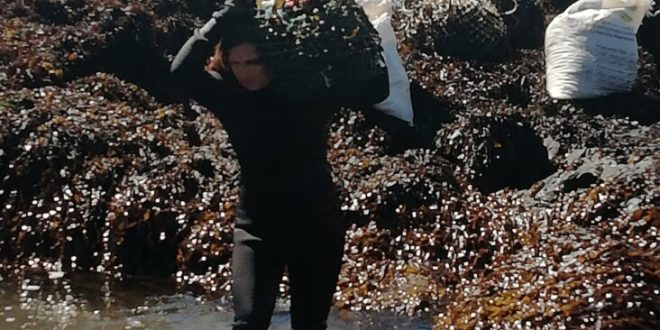
PAREDONES, Chile, Aug 05 (IPS) – The number of organisations that bring together fisherwomen who seek to be recognised as workers, make their harsh reality visible and escape the vulnerability in which they live is growing in Chile.
These women have always been present in the fishing sector, but have been ignored, classified as assistants, and relegated socially and economically.
There are 103,017 registered artisanal fisherpeople in Chile, and 26,438 of them are women who work as seaweed gatherers on the shore, known as algueras in Spanish, and related tasks.
According to statistics from the government’s National Fisheries Service (Sernapesca), in 2023 there were 1,850 artisanal fisherpeople’s organisations in Chile, of which 81 were made up of women alone.
The fisheries sector in this long and narrow South American country of 19.5 million people exported 3.4 million tonnes of fish and seafood in 2021, bringing in USD 8.5 billion.
Chile is one of the 12 largest fishing countries in the world, being its industrial fishery the most economically relevant.
Meanwhile, artisanal fishing is carried out in 450 coves or inlets where groups of fisherpeople operate from the far north to the southernmost point of the country, stretching 4,000 kilometres in a straight line.
Seaweed harvesting, which is mainly carried out by women, lasts from December to April. In the remaining seven months, the algueras barely survive on their savings and must reinvent themselves in order to earn an income.
The invisible seawomen
Marcela Loyola, 55, is the vice-president of Agrupación de Mujeres de Mar (Seawomen Group) in the coastal town of Bucalemu, which belongs to the municipality of Paredones. It is 257 kilometres south of Santiago and part of the O’Higgins region, bordering the southern part of the capital’s metropolitan area.
The Agrupación brings together 22 algueras, as well as fish filleters, weavers who sew and place the hooks spaced out in the fishing nets, and shellfish shuckers, who extract their edible meat.
“The main problem is that we fisherwomen are invisible throughout the country. We have always been in the shadow of our husbands. There is a lack of recognition of women also from the authorities, in society and policies,” she told IPS in the Bucalemu cove.
“There are many trade unions, but their projects only reach men, never anything that serves women. And we don’t have health, welfare, nothing”, claims Loyola.
Together with Sernapesca, her group launched an activity to legalise workers in artisanal fishery.
“We held an application day and a lot of people came because they didn’t have a licence. In Bucalemu alone, 60 people signed up. Some had fishing credentials, but no permit to collect cochayuyo (edible brown seaweed) or in other related activities,” she explained.
Bucalemu also hosted a National Meeting of Women of the Land and Sea on 31 May, attended by more than 100 delegates from different parts of Chile.
Gissela Olguín, 40, coordinator of the national Network of Seawomen in the O’Higgins region, told IPS that the meeting sought to defend seafood sovereignty.
“We are working to learn from seawomen about food sovereignty. From the right to land, water and seeds, we analysed how people of the sea are threatened today because the inequality of the rural model is now being repeated on the coast,” she said.

Women-only management area
Delfina Mansilla, 60, heads the Women’s Union of Algueras in the municipality of Pichilemu, also in O’Higgins, 206 kilometres south of Santiago. It brings together 25 members and is in charge of the La Puntilla management area, the only one given to women in central Chile.
The leader told IPS by telephone from her town that the management area has cochayuyo (Durvillaea antárctica) and huiro (Macrocystis integrifolia) seaweed, along with the bivalve molluscs called locos (Concholepas concholepas) as its main products.
The cochayuyo is extracted by going into the sea with a diving suit and using a knife to cut the stalk attached to the rocks so that the seaweed can grow back. In the case of huiro, an iron barrette, called chuzo by the algueras and fishermen, must be used.
“Our main issue is that the men are bothered by our management area and come diving in. Some people don’t respect women and also go into an area that was given to us and that we have taken care of for years,” she said.
These women sell the locos to restaurants in Pichilemu, while the cochayuyo is traded “in green (the estimated extraction, not yet extracted)”, to middlemen in Bucalemu.
According to Olguín, there has been significant growth in women’s organising nationwide thanks to the Gender Equity Law, number 20820, passed in 2020.
“The labour of women have been invisible in the fishing sector, and even more so within the fisheries organisation because, although unions have women, they are in the minority,” she said.
The law, she explained, opened up the possibility for women to train and organise themselves.
In spite of this progress, male chauvinist mentality persists in the fishery.
“They believe women can’t be on the boats or they have smaller spaces for them in the cove. It is a behaviour of men who still think that women only help in the fishing industry, but don’t work in it,” she said.

Critical situation of the algueras
The leader describes the situation of women seaweed gatherers as bad.
“The women who work at sea live and sleep in little shacks with minimal conditions. They don’t have water or electricity and everyone has to make do as best they can. The same goes for sanitation, they have to make makeshift toilets,” she said.
It is hard work because the timetable is set by the sea, she adds. The first low tides can be at 7:00 am or sometimes at noon in summer, with the sun over their heads.
“Conditions are always a bit extreme. Throwing seaweed out when cutting the cochayuyo is a job requiring much physical strength,” she explained.
Since the working season is short, the women prefer to stay in the shacks, improvised dwellings made of sticks and cloth that are erected on the sand or ground resembling tents.
“Here, women stop going to the sea only when their bodies prevent them from doing so. I know women over 70 who are still working on the shore because that’s how they subsist,” she added.
Another determining factor is the price of seaweed, which is set by buyers and ranges from 200 to 500 pesos per kilo (between 20 and 50 US cents).
The fisherwomen work long hours to extract more product. “It is a very vulnerable sector, with no social security or cultural recognition,” Olguín concluded Olguín.

The threat to seaweed
Alejandra González, a doctor in ecology and evolutionary biology at the University of Chile, told IPS that some species of brown and red macroalgae found along Chile’s coasts are raw material for the food, pharmacological and medical industries.
This commercial value and high demand leads to direct extraction, “causing a reduction in natural populations and fragmentation, with a slow recovery rate of only those that survive harvesting”, she explains.
“This scenario makes populations less able to cope with environmental change, leaving them vulnerable to events such as Enos (El Niño), heat waves, increased tidal surges, changes in seawater pH, many of them associated with climate change,” she said.
Among the greatest threats to macroalgae are habitat destruction due to coastal port constructions, pollution caused by urbanization, and invasive species associated with ship movements and migrations.
Other threats are overexploitation related to human population growth, climate change caused by increased carbon dioxide (CO2) and its side effects, such as higher temperatures, storm surges and chemical changes.
According to González, the greatest threat to seaweed is the combination of all these variables.
Chile has developed various strategies for the conservation and management of natural seaweed meadows, but these measures are inadequate, argues the specialist.
“In Chile’s north, the exploitation of brown macroalgae from natural meadows is greater, because drying is free on the beaches themselves, but it is also affected by El Niño current events. While in the south it is necessary to invest in sheds or drying systems, it is more efficient to cultivate them because there are tamer bays,” she said.
González also believes that measures to recover natural seaweed meadows are not efficient “either because of legal loopholes, difficulties in on-site monitoring and/or other additional environmental variables such as those associated with climate change.”
© Inter Press Service (2024) — All Rights ReservedOriginal source: Inter Press Service
 Top Naija News – Nigeria News, Nigerian News & Top Stories Top Naija News – Nigerian Newspapers, Nigerian News. topnaijanews is a daily Nigerian newspaper covering Latest News, Breaking News, Entertainment, Sports, Lifestyle and Politics.
Top Naija News – Nigeria News, Nigerian News & Top Stories Top Naija News – Nigerian Newspapers, Nigerian News. topnaijanews is a daily Nigerian newspaper covering Latest News, Breaking News, Entertainment, Sports, Lifestyle and Politics.




